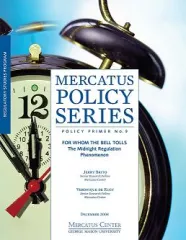In a series of studies, Mercatus Center scholars examined the phenomenon of “midnight regulations,” or regulations promulgated between a presidential election day and an inauguration day.
History teaches us that the outcome of presidential elections is rarely certain, with one exception. A change in administration will be followed by a “lame duck” session, during which politicians are all-but freed from normal political constraints. For an administration, this period provides what is often its best—and sometimes last—chance to push through sweeping and controversial regulations.
In a series of studies, Mercatus Center scholars examined the phenomenon of “midnight regulations,” or regulations promulgated between a presidential election day and an inauguration day. Key findings include:
- Surges Occur Regardless of Election Outcome. While the largest surges in midnight regulations occur under outgoing administrations, smaller surges are evident even when an incumbent president is reelected. These surges are systemic and cross party lines.
- Analysis is Poor. The quality of regulatory analysis for midnight regulations is poorer than average, which may lead to less efficient use of federal resources.
- Review is Rushed. The surge in midnight regulation can overwhelm the Office of Information and Regulatory Affairs (OIRA), which is charged with reviewing the quality of agencies’ regulatory analysis. This can result in rushed, flawed oversight, further undermining the quality check on proposed regulations.
- Repeal is Difficult. Like all regulations, once passed, midnight regulations often prove extremely difficult to repeal.
Below is a brief summary of the study series. To read the studies in their entirety and learn more about the authors, please follow the appropriate links. For more information—including a regularly updated list of this year’s potential midnight regulations—please visit the Mercatus Center’s Midnight Regulations page.
SUMMARY
New Regulations Surge During Midnight Period. Under normal circumstances, pages are added to the Federal Register—which includes all new and proposed regulations—at a constant rate of about 25 percent per quarter throughout the course of a year. During a midnight period, however, the number of pages added has exceeded the 25-percent baseline 13 out of 15 times since 1946. The two exceptions followed the elections of 1976, when Ford was succeeded by Carter, and 1984, when Reagan was elected to a second term.
- When control of the White House switched parties, the volume of regulation in the outgoing administration’s share of pages added during midnight months is 17 percent higher than the volume of rules issued during the same period in non-election years.
- The midnight months’ share of pages increases to18 percent for an outgoing administration, and 20 percent for an outgoing party. –Antony Davies, Duquesne University, and Veronique de Rugy, Midnight Regulations and the Cinderella Effect, Mercatus Working Paper, October 2009.
Political-Appointee Turnover May Be Key to Surges. The lack of political accountability to either Congress or voters provides both the president and his political appointees in executive agencies an opportunity to push through sweeping controversial regulations that would normally espouse considerable opposition. Since the turnover among political appointees is the highest during the change in administration, it produces the highest regulatory surge. Yet, even if an incumbent president is reelected, a number of agency heads depart the administration, producing a mini-surge. –Antony Davies, Duquesne University, and Veronique de Rugy, Midnight Regulations and the Cinderella Effect, Mercatus Working Paper, October 2009; Jay Cochran, George Mason University, The Cinderella Constraint, Mercatus Working Paper, March 2001.
Quality of Midnight Regulations Lower Than Normal. To ensure effective use of federal resources, executive agencies complete regulatory impact analyses for “economically significant regulations,” or regulations with an impact on the economy in excess of $100 million. The Mercatus Center’s Regulatory Report Card scores the analytical quality of proposed economically significant regulations based on the following criteria: the need for regulation, the thoroughness of economic analysis, and the use of analysis in selecting a regulatory alternative.
Using Regulatory Report Card data, Mercatus scholars examined the regulatory impact analysis quality for economically significant regulations passed in 2008, the last year of Bush Administration. Out of the 30 prescriptive regulations promulgated that year, six were finalized during the midnight period. Non-midnight regulations scored an average 34 out of 60 points (an equivalent of an ‘F’ on most grading scales). Midnight regulations scored even worse: on average they received only 26 points—a significant drop in analytical quality. –Patrick McLaughlin and Jerry Ellig, Does Haste Make Waste in Regulatory Analysis? Mercatus Working Paper, November 2010.
Regulatory Oversight Suffers During Surge. The midnight regulatory surge is rarely accompanied by a commensurate increase in OIRA’s budget or staff, leaving the agency ill equipped to perform adequate oversight. These manpower shortages lead to shorter OIRA review times. Between 1994 and 2007, the average OIRA review time for an economically significant rule was about 50 days; for midnight regulations, it was only half that (25 days). –Patrick McLaughlin, Empirical Tests for Midnight Regulations and Their Effect on OIRA Review Time, Mercatus Working Paper, September 2008; Jerry Brito and Veronique de Rugy, Midnight Regulations and Regulatory Review, Administrative Law Review, Winter 2009.
A First Step in Stemming the Surge. There are no silver bullets when it comes to stopping the midnight surge. A comprehensive solution would require a set of reforms addressing political appointees’ incentives, as well as OIRA’s ability to effectively oversee the quality of regulatory analysis. For the latter, Mercatus research suggests a rolling 90-day cap should be implemented to prevent a regulatory surge and to ensure that OIRA has sufficient manpower for thorough oversight of regulatory analysis. Specifically, this would include capping the number of major regulations an agency can submit for OIRA review within any given 90-day period and giving OIRA up to 90 days to review major regulations. – Jerry Brito and Veronique de Rugy, Midnight Regulations and Regulatory Review, Administrative Law Review, Winter 2009.
*Prescriptive regulations are the traditional regulations that prescribe specific actions, as opposed to transfer regulations that implement federal spending and revenue collection laws.


